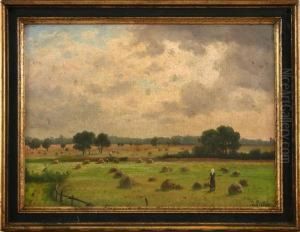Julius Theodor Preller Paintings
Julius Theodor Preller was a German landscape painter born on September 1, 1804, in Eisenach, which was then part of the Grand Duchy of Saxe-Weimar-Eisenach. He was initially trained by his father, Friedrich Preller the Elder, who was also an accomplished painter and draughtsman. Influenced by the Romantic movement, Preller developed an interest in capturing the sublime aspects of nature in his works.
In 1821, he began his formal art education at the Weimar Princely Free Drawing School (Fürstliche freie Zeichenschule Weimar), where he studied under the directorship of Johann Heinrich Meyer, a friend and collaborator of the famous German writer and statesman Johann Wolfgang von Goethe. Preller's early works were influenced by the Weimar art circle and the German Romantic painters such as Caspar David Friedrich.
Preller's artistic journey led him to the Dresden Academy of Fine Arts, where he further honed his skills and developed his unique style. He also spent time in Italy, a common practice among artists of the period, which had a profound effect on his work. The Italian landscape and light deeply influenced Preller, and he began to incorporate elements of the Italian scenery into his paintings.
Throughout his career, Preller was known for his seascapes and landscapes, which often included mythological or historical subjects. One of his notable contributions to the art world was his work on the 'Odyssey landscapes' (Odysseus-Landschaften), a series of paintings that depicted scenes from Homer's Odyssey. These works were commissioned for the Grand Ducal Museum in Weimar and reflect Preller's skill in blending classical themes with natural landscapes.
Preller held a teaching position at the Weimar Saxon-Grand Ducal Art School, influencing a generation of German artists. His legacy is also tied to his son, Friedrich Preller the Younger, who followed in his father's footsteps as a landscape painter.
Julius Theodor Preller died on May 12, 1878, in Weimar. His works continue to be appreciated for their romantic sensibility and their evocative portrayal of nature's beauty. He left behind a body of work that resonates with the ideals of the Romantic era and remains of historical significance to German art history.
